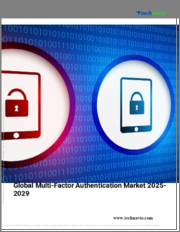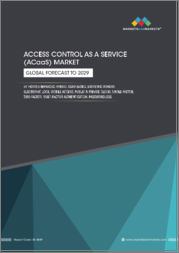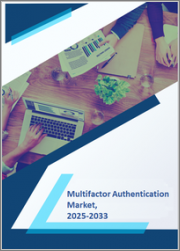
|
시장보고서
상품코드
1453932
다중 인증 시장 예측(-2030년) : 인증 유형별, 모델 유형별, 구성요소별, 최종사용자별, 지역별 세계 분석Multi-Factor Authentication Market Forecasts to 2030 - Global Analysis By Authentication Type (Passwordless Authentication and Password-Based Authentication), Model Type, Component, End User, and By Geography |
||||||
Stratistics MRC에 따르면, 세계 다중 인증 시장은 2023년 165억 9,000만 달러로 예측 기간 동안 16.2%의 CAGR로 성장하여 2030년에는 474억 7,000만 달러에 달할 것으로 예상됩니다.
다중 인증(MFA)은 사용자가 계정이나 시스템에 접속할 때 여러 가지 인증 수단을 제공하도록 요구하는 보안 조치입니다. 일반적으로 사용자가 알고 있는 것(비밀번호 등)과 사용자가 가지고 있는 것(SMS를 통한 코드 수신용 스마트폰, 토큰 생성기 등) 또는 사용자가 가지고 있는 것(지문, 얼굴 인증 등)을 조합하여 인증하는 방식입니다. 하나의 인증 정보만으로는 계정에 침입하는 것을 어렵게 만들어 무단 액세스에 대한 보호 계층을 추가하여 보안을 강화합니다.
미국 연방거래위원회(FTC)에 따르면 2021년 한 해 동안 588만 건 이상의 사기 신고가 포털에 접수됐습니다.
클라우드 서비스 도입 증가
MFA 솔루션은 기존의 비밀번호를 넘어서는 인증 계층을 추가함으로써 클라우드 리소스에 대한 액세스를 보장하는 데 중요한 역할을 합니다. 서비스), PaaS(Platform-as-a-Service) 등의 클라우드 서비스를 통해 사용자는 언제 어디서나 다양한 디바이스를 통해 데이터와 애플리케이션에 접근할 수 있습니다. 또한, 이러한 솔루션은 사용자의 신원 인증이 필요한 문제를 해결하고 있으며, 이는 이 시장을 더욱 촉진하는 요인으로 작용하고 있습니다.
높은 비용
MFA 솔루션 도입에는 하드웨어 토큰, 생체인식 장치, 소프트웨어 라이선스에 대한 선투자, 지속적인 유지보수 비용 등 여러 가지 비용이 발생합니다. 예산이 한정된 중소기업이나 조직에 있어 MFA에 필요한 초기 투자비용이 부담스러울 수 있습니다. 또한 유지보수, 업그레이드 및 사용자 지원과 관련된 지속적인 비용도 MFA 솔루션의 총 소유 비용에 추가적으로 기여합니다.
의식 제고와 교육
조직은 취약한 인증 관행의 위험에 대해 사용자를 교육하고 MFA 기술 채택을 촉진하기 위해 직원 교육 프로그램 및 사이버 보안 교육에 투자하고 있습니다. 교육 이니셔티브, 사이버 보안 교육 캠페인, 유명 보안 침해 사건에 대한 언론 보도가 MFA에 대한 이해를 높이는 데 기여하고 있습니다. 또한, 사용자에게 MFA의 장점과 중요성에 대한 지식을 제공함으로써 조직은 보다 효과적으로 채택 및 도입 노력을 촉진할 수 있습니다.
표준화 부족
MFA에 대한 보편적인 표준이 없기 때문에 다양한 벤더들이 독자적인 인증 방식과 프로토콜을 제공하고 있으며, 이는 시장의 분열을 초래할 수 있습니다. 이러한 표준화의 부재는 통합 작업을 복잡하게 만들고, 도입 비용을 증가시키며, MFA 솔루션과 기존 IT 인프라 및 애플리케이션과의 상호운용성을 제한합니다. 또한, 일관성 없는 MFA 구현은 혼란과 불만을 야기하고, 보안 인증 방법 사용에 대한 거부감을 불러일으켜 시장 성장을 저해할 수 있습니다.
COVID-19의 영향
COVID-19는 다중 인증(MFA) 시장에 다양한 영향을 미쳤습니다. 팬데믹으로 인한 경제적 불안으로 인해 일부 기업들은 MFA 프로젝트를 포함한 사이버 보안 이니셔티브에 대한 투자를 연기하거나 축소하고, 비용 절감 및 비즈니스 연속성 노력을 우선순위에 두었습니다. 그러나 일부 기업들은 팬데믹으로 인한 당면 과제 속에서 자원을 할당하고 사이버 보안 투자에 대한 우선순위를 정하는 데 어려움을 겪었고, 그 결과 시장 확대에 차질을 빚었을 수 있습니다.
예측 기간 동안 비밀번호 기반 인증 분야가 가장 큰 비중을 차지할 것으로 예상
비밀번호 기반 인증은 사용자가 계정이나 시스템에 액세스하기 위해 단일 요소(일반적으로 비밀번호 또는 암호)를 제공하는 것을 포함하기 때문에 기본 추정 점유율이 가장 큽니다. 여기에는 생체인식 인증, 일회용 비밀번호(OTP), 인증 코드 등의 방법이 포함됩니다. 또한, 비밀번호뿐만 아니라 사용자에게 추가적인 인증 수단을 요구하여 보안을 강화하는 MFA 솔루션에 대한 수요가 증가함에 따라 이 부문의 성장을 견인하고 있습니다.
예측 기간 동안 가장 높은 CAGR을 기록할 것으로 예상되는 하드웨어 부문
하드웨어 부문은 조직과 개인에게 안전하고 신뢰할 수 있는 인증 솔루션을 제공하는 데 중요한 역할을 하기 때문에 예측 기간 동안 가장 높은 CAGR을 기록할 것으로 예상됩니다. 이 분야는 토큰이나 스마트 카드와 같은 물리적 장치를 사용하여 인증 자격 증명을 생성하거나 저장합니다. 또한, 이러한 솔루션은 오프라인 기능, 피싱 공격에 대한 내성, 업계 규정 및 표준 준수와 같은 이점을 가지고 있어 이 부문의 성장을 촉진하고 있습니다.
지역별 점유율
북미 지역은 사이버 보안에 대한 관심 증가, 규제 요건 강화, 다양한 산업 분야에서 디지털 기술의 광범위한 채택으로 인해 예측 기간 동안 가장 큰 시장 점유율을 차지했습니다. 이 지역에는 미국, 캐나다, 멕시코가 포함되며, 수많은 기술 기업, 금융 기관, 정부 기관, 사이버 보안을 우선시하는 기업이 있습니다. 또한, 기업 및 정부 기관은 기밀 데이터를 보호하고 무단 액세스를 방지하기 위해 MFA 솔루션에 대한 투자를 늘리고 있으며, 이는 이 지역의 시장 규모를 확대하고 있습니다.
CAGR이 가장 높은 지역:
유럽은 데이터 보호, 프라이버시 규제, 사이버 보안에 대한 인식이 높아 예측 기간 동안 가장 높은 CAGR을 기록할 것으로 예상됩니다. 또한, 스푸핑, 피싱 공격, 데이터 유출과 같은 사이버 위협이 증가함에 따라 기업들은 위험을 줄이기 위해 MFA 솔루션을 채택하고 있습니다. 업계 관계자, 정부 기관 및 규제 기관의 협력은 유럽에서 MFA 기술의 성장과 채택에 기여하고 있습니다.
무료 맞춤형 서비스:
이 보고서를 구독하는 고객은 다음과 같은 무료 맞춤화 옵션 중 하나를 사용할 수 있습니다:
- 기업 개요
- 추가 시장 기업의 종합적인 프로파일링(최대 3개사까지)
- 주요 기업 SWOT 분석(최대 3개사)
- 지역 세분화
- 고객의 관심에 따른 주요 국가별 시장 추정치, 예측, CAGR(주: 타당성 검토에 따른)
- 경쟁사 벤치마킹
- 제품 포트폴리오, 지리적 입지, 전략적 제휴를 기반으로 한 주요 기업 벤치마킹
목차
제1장 주요 요약
제2장 서문
- 개요
- 이해관계자
- 조사 범위
- 조사 방법
- 데이터 마이닝
- 데이터 분석
- 데이터 검증
- 조사 접근법
- 조사 소스
- 1차 조사 소스
- 2차 조사 소스
- 가정
제3장 시장 동향 분석
- 성장 촉진요인
- 성장 억제요인
- 기회
- 위협
- 최종사용자 분석
- 신흥 시장
- 신종 코로나바이러스 감염증(COVID-19)의 영향
제4장 Porter's Five Forces 분석
- 공급 기업의 교섭력
- 구매자의 교섭력
- 대체품의 위협
- 신규 참여업체의 위협
- 경쟁 기업 간의 경쟁 관계
제5장 세계의 다중 인증 시장 : 인증 유형별
- 패스워드리스 인증
- 패스워드 기반 인증
제6장 세계의 다중 인증 시장 : 모델 유형별
- 2 요소 인증
- 3 요소 인증
- 4 요소 인증
- 5 요소 인증
- 기타 모델 유형
제7장 세계의 다중 인증 시장 : 컴포넌트별
- 하드웨어
- 서비스
- 소프트웨어
제8장 세계의 다중 인증 시장 : 최종사용자별
- 은행, 금융 서비스, 보험(BFSI)
- 정부와 방위
- 헬스케어
- IT와 통신
- 소매
- 에너지와 유틸리티
- 제조업
- 교육
- 기타 최종사용자
제9장 세계의 다중 인증 시장 : 지역별
- 북미
- 미국
- 캐나다
- 멕시코
- 유럽
- 독일
- 영국
- 이탈리아
- 프랑스
- 스페인
- 기타 유럽
- 아시아태평양
- 일본
- 중국
- 인도
- 호주
- 뉴질랜드
- 한국
- 기타 아시아태평양
- 남미
- 아르헨티나
- 브라질
- 칠레
- 기타 남미
- 중동 및 아프리카
- 사우디아라비아
- 아랍에미리트
- 카타르
- 남아프리카공화국
- 기타 중동 및 아프리카
제10장 주요 발전
- 계약, 파트너십, 협업, 합작투자
- 인수와 합병
- 신제품 발매
- 사업 확대
- 기타 주요 전략
제11장 기업 개요
- IBM Corporation
- Vasco Data Security International, Inc.
- Thales
- Safran S.A.
- Gemalto NV
- Microsoft Corporation
- Okta
- Fujitsu America, Inc.
- Salesforce.com, Inc.
- 3M
- RSA Security LLC
- Google LLC
- CA Technologies
- Symantec Corporation
- Ping Identity Corporation
According to Stratistics MRC, the Global Multi-Factor Authentication Market is accounted for $16.59 billion in 2023 and is expected to reach $47.47 billion by 2030 growing at a CAGR of 16.2% during the forecast period. Multi-Factor Authentication (MFA) is a security measure that requires users to provide multiple forms of verification to access an account or system. Typically, this involves combining something the user knows (like a password) with something they have (like a smartphone for receiving a code via SMS or a token generator) and/or something they are (like a fingerprint or facial recognition). MFA enhances security by adding layers of protection against unauthorized access, as it makes it more difficult for attackers to breach an account solely by obtaining one piece of authentication information.
According to the US Federal Trade Commission (FTC), more than 5.88 million fraud reports were received on their portal in 2021.
Market Dynamics:
Driver:
Increasing adoption of cloud services
MFA solutions play a critical role in securing access to cloud resources by adding an additional layer of authentication beyond traditional passwords. Cloud services, such as Software-as-a-Service (SaaS), Infrastructure-as-a-Service (IaaS), and Platform-as-a-Service (PaaS), enable users to access data and applications from anywhere, at any time, using various devices. In addition, these solutions address challenges by requiring users to authenticate their identities, which drive this market further.
Restraint:
High cost
Implementing MFA solutions involves several expenses, including upfront investments in hardware tokens, biometric devices, software licenses, and ongoing maintenance costs. For smaller businesses or organizations with limited budgets, the initial investment required for MFA may be perceived as prohibitively high. Additionally, ongoing expenses related to maintenance, upgrades, and user support further contribute to the total cost of ownership for MFA solutions.
Opportunity:
Rising awareness and education
Organizations are investing in employee training programs and cybersecurity awareness initiatives to educate users about the risks of weak authentication practices and promote the adoption of MFA technologies. Education initiatives, cybersecurity awareness campaigns, and media coverage of high-profile security breaches have contributed to a greater understanding. Moreover, by empowering users with knowledge about the benefits and importance of MFA, organizations can drive adoption and implementation efforts more effectively.
Threat:
Lack of standardization
The absence of universal standards for MFA can lead to fragmentation within the market, with different vendors offering proprietary authentication methods and protocols. This lack of standardization complicates integration efforts, increases implementation costs, and limits the interoperability of MFA solutions with existing IT infrastructure and applications. Additionally, inconsistencies in MFA implementations can lead to confusion, frustration, and resistance to using secure authentication methods, hence hindering market growth.
Covid-19 Impact
The COVID-19 pandemic has had a mixed impact on the Multi-Factor Authentication (MFA) market. The economic uncertainty caused by the pandemic prompted some organizations to postpone or scale back investments in cybersecurity initiatives, including MFA projects, as they prioritized cost-cutting measures and business continuity efforts. However, some businesses may have struggled to allocate resources and prioritize cybersecurity investments amidst the immediate challenges posed by the pandemic, which thereby impeded market expansion.
The password-based authentication segment is expected to be the largest during the forecast period
The password-based authentication segment is estimated to hold the largest share because it involves users providing a single factor-typically a password or passphrase-to access their accounts or systems. This includes methods such as biometric authentication, one-time passwords (OTPs), and authentication codes. Moreover, there is a growing demand for MFA solutions that enhance security by requiring users to provide additional forms of verification beyond just a password, which is boosting this segment's expansion.
The hardware segment is expected to have the highest CAGR during the forecast period
The hardware segment is anticipated to have highest CAGR during the forecast period due to its crucial role in providing secure and reliable authentication solutions to organizations and individuals. It involves the use of physical devices, such as tokens or smart cards, to generate or store authentication credentials. Furthermore, these solutions offer advantages such as offline functionality, resilience to phishing attacks, and compliance with industry regulations and standards, thereby driving this segment's growth.
Region with largest share:
North America commanded the largest market share during the extrapolated period owing to increasing cybersecurity concerns, stringent regulatory requirements, and widespread adoption of digital technologies across various industries. The region encompasses the United States, Canada, and Mexico, which are home to a large number of technology companies, financial institutions, government agencies, and enterprises that prioritize cybersecurity. Additionally, businesses and government entities are increasingly investing in MFA solutions to protect sensitive data and prevent unauthorized access, which thereby increases this region's size.
Region with highest CAGR:
Europe is expected to witness highest CAGR over the projection period, owing to a strong focus on data protection, privacy regulations, and cybersecurity awareness. Additionally, the rise in cyber threats, including identity theft, phishing attacks, and data breaches, has propelled organizations to adopt MFA solutions to mitigate risks. Collaborations between industry stakeholders, government agencies, and regulatory bodies contribute to the growth and adoption of MFA technologies in Europe.
Key players in the market
Some of the key players in the Multi-Factor Authentication Market include IBM Corporation, Vasco Data Security International, Inc., Thales, Safran S.A., Gemalto NV, Microsoft Corporation, Okta,, Fujitsu America, Inc., Salesforce.com, Inc. , 3M, RSA Security LLC, Google LLC, CA Technologies, Symantec Corporation and Ping Identity Corporation.
Key Developments:
In January 2024, Google and Worldline announced a strategic partnership designed to leverage cutting-edge cloud-based technologies from google cloud to take worldline's digital transformation further.
In December 2023, IBM announced that it has entered into a definitive agreement with Software AG, a company majority owned by Silver Lake, to purchase StreamSets and webMethods, Software AG's Super iPaaS (integration platform-as-a-service) enterprise technology platforms, for €2.13 billion in cash.
In September 2023, Thales and Kyndryl announced partnership for comprehensive response to cybersecurity incidents.
Authentication types Covered:
- Passwordless Authentication
- Password-Based Authentication
Model Types Covered:
- Two Factor Authentication
- Three Factor Authentication
- Four Factor Authentication
- Five-Factor Authentication
- Other Model Types
Components Covered:
- Hardware
- Services
- Software
End Users Covered:
- Banking, Financial Services, and Insurance (BFSI)
- Government and Defense
- Healthcare
- IT and Telecommunications
- Retail
- Energy and Utilities
- Manufacturing
- Education
- Other End Users
Regions Covered:
- North America
- US
- Canada
- Mexico
- Europe
- Germany
- UK
- Italy
- France
- Spain
- Rest of Europe
- Asia Pacific
- Japan
- China
- India
- Australia
- New Zealand
- South Korea
- Rest of Asia Pacific
- South America
- Argentina
- Brazil
- Chile
- Rest of South America
- Middle East & Africa
- Saudi Arabia
- UAE
- Qatar
- South Africa
- Rest of Middle East & Africa
What our report offers:
- Market share assessments for the regional and country-level segments
- Strategic recommendations for the new entrants
- Covers Market data for the years 2021, 2022, 2023, 2026, and 2030
- Market Trends (Drivers, Constraints, Opportunities, Threats, Challenges, Investment Opportunities, and recommendations)
- Strategic recommendations in key business segments based on the market estimations
- Competitive landscaping mapping the key common trends
- Company profiling with detailed strategies, financials, and recent developments
- Supply chain trends mapping the latest technological advancements
Free Customization Offerings:
All the customers of this report will be entitled to receive one of the following free customization options:
- Company Profiling
- Comprehensive profiling of additional market players (up to 3)
- SWOT Analysis of key players (up to 3)
- Regional Segmentation
- Market estimations, Forecasts and CAGR of any prominent country as per the client's interest (Note: Depends on feasibility check)
- Competitive Benchmarking
- Benchmarking of key players based on product portfolio, geographical presence, and strategic alliances
Table of Contents
1 Executive Summary
2 Preface
- 2.1 Abstract
- 2.2 Stake Holders
- 2.3 Research Scope
- 2.4 Research Methodology
- 2.4.1 Data Mining
- 2.4.2 Data Analysis
- 2.4.3 Data Validation
- 2.4.4 Research Approach
- 2.5 Research Sources
- 2.5.1 Primary Research Sources
- 2.5.2 Secondary Research Sources
- 2.5.3 Assumptions
3 Market Trend Analysis
- 3.1 Introduction
- 3.2 Drivers
- 3.3 Restraints
- 3.4 Opportunities
- 3.5 Threats
- 3.6 End User Analysis
- 3.7 Emerging Markets
- 3.8 Impact of Covid-19
4 Porters Five Force Analysis
- 4.1 Bargaining power of suppliers
- 4.2 Bargaining power of buyers
- 4.3 Threat of substitutes
- 4.4 Threat of new entrants
- 4.5 Competitive rivalry
5 Global Multi-Factor Authentication Market, By Authentication Type
- 5.1 Introduction
- 5.2 Passwordless Authentication
- 5.3 Password-Based Authentication
6 Global Multi-Factor Authentication Market, By Model Type
- 6.1 Introduction
- 6.2 Two Factor Authentication
- 6.3 Three Factor Authentication
- 6.4 Four Factor Authentication
- 6.5 Five-Factor Authentication
- 6.6 Other Model Types
7 Global Multi-Factor Authentication Market, By Component
- 7.1 Introduction
- 7.2 Hardware
- 7.3 Services
- 7.4 Software
8 Global Multi-Factor Authentication Market, By End User
- 8.1 Introduction
- 8.2 Banking, Financial Services, and Insurance (BFSI)
- 8.3 Government and Defense
- 8.4 Healthcare
- 8.5 IT and Telecommunications
- 8.6 Retail
- 8.7 Energy and Utilities
- 8.8 Manufacturing
- 8.9 Education
- 8.10 Other End Users
9 Global Multi-Factor Authentication Market, By Geography
- 9.1 Introduction
- 9.2 North America
- 9.2.1 US
- 9.2.2 Canada
- 9.2.3 Mexico
- 9.3 Europe
- 9.3.1 Germany
- 9.3.2 UK
- 9.3.3 Italy
- 9.3.4 France
- 9.3.5 Spain
- 9.3.6 Rest of Europe
- 9.4 Asia Pacific
- 9.4.1 Japan
- 9.4.2 China
- 9.4.3 India
- 9.4.4 Australia
- 9.4.5 New Zealand
- 9.4.6 South Korea
- 9.4.7 Rest of Asia Pacific
- 9.5 South America
- 9.5.1 Argentina
- 9.5.2 Brazil
- 9.5.3 Chile
- 9.5.4 Rest of South America
- 9.6 Middle East & Africa
- 9.6.1 Saudi Arabia
- 9.6.2 UAE
- 9.6.3 Qatar
- 9.6.4 South Africa
- 9.6.5 Rest of Middle East & Africa
10 Key Developments
- 10.1 Agreements, Partnerships, Collaborations and Joint Ventures
- 10.2 Acquisitions & Mergers
- 10.3 New Product Launch
- 10.4 Expansions
- 10.5 Other Key Strategies
11 Company Profiling
- 11.1 IBM Corporation
- 11.2 Vasco Data Security International, Inc.
- 11.3 Thales
- 11.4 Safran S.A.
- 11.5 Gemalto NV
- 11.6 Microsoft Corporation
- 11.7 Okta
- 11.8 Fujitsu America, Inc.
- 11.9 Salesforce.com, Inc.
- 11.10 3M
- 11.11 RSA Security LLC
- 11.12 Google LLC
- 11.13 CA Technologies
- 11.14 Symantec Corporation
- 11.15 Ping Identity Corporation



















